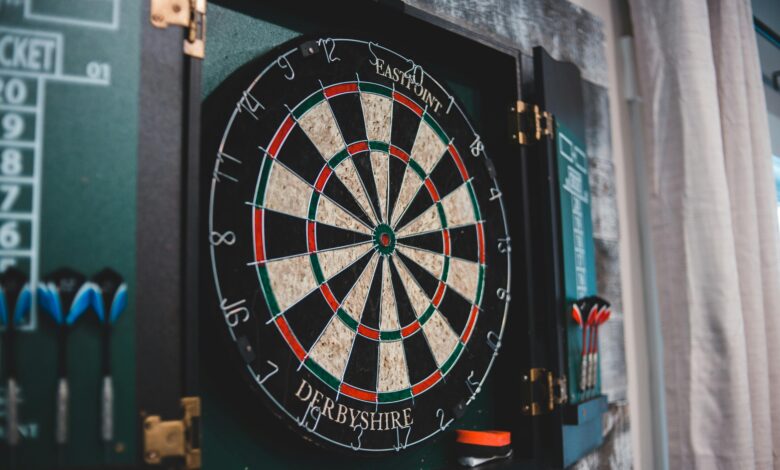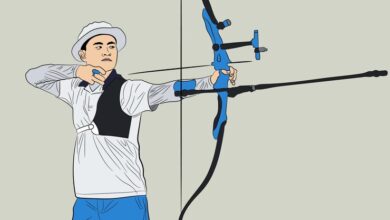How To Calculate Darts Averages?

How To Calculate Darts Averages? Let’s say you want to improve your skills or are new to darts. If so, one of the most important things you can do to improve as a player is to learn how to compute darts averages.
By dividing your total points scored by the total number of darts thrown, you may find your darts average and multiplying the result by three. Assuming that your darts average is equal to (Total Points ÷ Darts Thrown) x 3.
How Do Averages Measure Progress And Performance?
In darts, it’s critical to gauge player improvement and performance, and averages are a key tool for this. Players can assess their overall skill level and consistency by computing the average.
A higher average suggests skill and a higher probability of winning games, whereas a lower average could point to areas that need work. The average is calculated by adding together all of the scores and dividing it by the total number of darts thrown.
This statistical metric offers a trustworthy depiction of a player’s skills across a specific time frame, facilitating analysis and comparison.
Averages also make it simpler to see a player’s strengths and shortcomings by highlighting patterns and trends in their play.
For instance, if a player consistently scores low on certain rounds, they can focus on improving those specific areas. Additionally, averages enable players to set achievable goals and track their progress over time.
Is There A Specific Notation For Recording Darts Averages?
There is a special notation for keeping track of dart averages that is frequently employed in leagues and tournaments.
The notation makes it possible to precisely record and evaluate a player’s performance throughout several games or seasons.
The total number of darts thrown, the number of darts that reach the intended target (often the triple 20 in professional matches), and the total number of points earned are the three main statistics that are typically used in the notation scheme to determine the average.
Subtracting the total number of points earned from the total number of darts thrown provides the average, which serves as a measure of a player’s accuracy and consistency.
The most typical way to write this notation is as a three-digit figure: the first digit is the number of triple 20s hit, the second is the number of doubles hit, and the third is the number of singles hit.
The total number of darts thrown is shown after the third digit. Players, fans, and analysts can all readily comprehend and compare performance across various players and matches thanks to this standardized notation.
Are There Online Tools For Calculating Darts Averages?
Yes, darts averages can be computed using a variety of web tools. With the use of these tools, players can compute their average score per dart or per round by entering their scores and the quantity of darts shot.
A couple of well-liked web resources for figuring out darts averages are DartConnect and Darts501. Players can compare their averages with other players, assess their performance, and monitor their growth with the use of these tools.
FAQS:
Q1: Can you provide an example of calculating a darts average?
Sure! Let’s imagine a player throws 100 darts and scores a total of 300 points. It would be (300 / 100) × 3 = 9 in math. The average for darts would be 9.
Q2: Is it necessary to throw a specific number of darts to calculate an average?
No, any number of darts thrown can be used to generate a darts average. However, the average gets more precise as more darts are fired.
Q3: Can you calculate separate averages for different games or sessions?
The total points scored in each game or session and the total number of darts thrown in each game or session can be used to compute separate averages for each game or session.
Q4: What is a good darts average?
Depending on the level of play and the particular game or format, a good darts average can change. High-level competitors frequently have averages over 100 in professional events. Averages can, however, change significantly between players and skill levels.
Q5: How can I track my darts averages?
By keeping track of your results and the number of darts thrown during drills or competitions, you may monitor your dart averages. You can monitor your progress with a scorecard or a mobile scoring app.
Q6: Can darts averages be used for competitive purposes?
The answer is that in competitive play, darts averages are frequently used to evaluate player performance and establish rankings. They offer a numerical evaluation of a player’s aptitude and reliability.
Q7: Can darts averages improve over time?
Yes, with practice and experience, dart averages can rise over time. Players’ averages typically rise as they improve their technique, accuracy, and consistency. Darts averages can be raised with consistent practice and targeted training.
Summary:
To sum up, Calculating darts averages is a crucial skill for any serious darts player. By understanding and implementing the methods outlined in this article, players can precisely measure their performance and monitor their progress over time.
Although the process may seem complicated initially, with practice and experience, it becomes an intuitive tool for self-improvement.
Utilizing averages not only provides valuable insights but also helps players set goals and work towards achieving them. So, challenge yourself to calculate the numbers, track your progress, and take your darts game to the next level.


